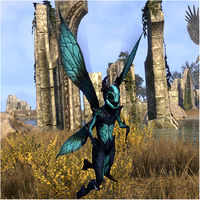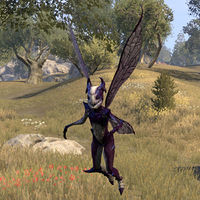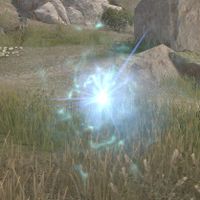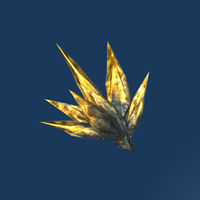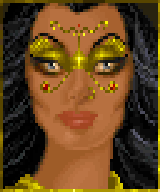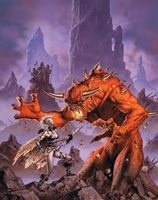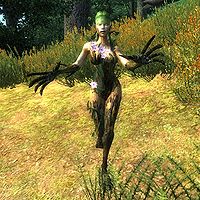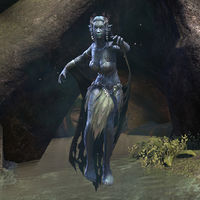Lore:Faerie
Faerie, also called Fey,[1] Fay,[2] and Fairy/Fairies[3][4] are magical, mischievous, and unpredictable creatures that come in a variety of forms. Their plans and schemes are not governed by a higher purpose, simply by their own whim.[1] Their behaviors have borne them the reputation of thieves, tricksters, and nuisances.[5]
References to fairies commonly appear throughout many cultures, such as fantasy plays commonly involving fairies,[6] the ability of the Mage birthsign named for the Fay,[7] and expressions based on faerie behavior,[8] notably the term "fairy tale" for mythical stories.[9] Some exclamations among the Altmer and Bosmer are "Faeries of the Grove"[10][11] and "Faerielight".[12][13]
Fairies are most commonly described as inhabiting the Summerset Isles,[14] with some variants reported as inhabiting no other province besides it.[15] Fairy civilizations inhabited Valenwood prior to the arrival of the Aldmer.[3] Faeries were also known to inhabit the banks of the Karth River.[16]
The Faerie Chain[edit]
Ahrtabazus, a scholar studying at the Crystal Tower, developed a controversial theory about Faerie dubbed the "Faerie Chain" by organizing the Fey variants on a hierarchical chain, published in 2E 456 in Firsthold. It ranged from minor creatures like pixies at one end and the godlike beings such as Gheatus at the other. In the middle were human and semi-human beings, generating up to intelligent trees, brooks, rocks, even mountains. He received much criticism for adding the footnote that elves as a whole may be part of the chain, above whilloki and below nephrine, due to their similar features and propensities for magicka that Faerie have.[1]
The chain is not necessarily an order of command, as faerie as a whole are neither followers nor leaders. Ahrtabazus was challenged on his assumptions by other scholars based on very slight coincidences. Due to its reliance on coincidental evidence and supporting auxiliary theories, the chain is considered by some to be wrong. Nevertheless, Ahrtabazus modified his Fairie Chain theory, which has gained wider and wider acceptance since its publication.[1]
Species[edit]
Sprites[edit]
Sprites are fay creatures that appear as floating orbs of light.[1][17] Certain curses are capable of transforming people into sprites.[18]
Sylphim[edit]
Sylphim refers to minor fairies, often found surrounding other more powerful faeries, such as Gheatus or Sygria.[1]
Pixies[edit]
Pixies (called Whilloki by the Redguards)[1] are a type of fay described as appearing as glimmering sparks with the personality of whimsical pranksters.[1][4]
Nixads[edit]
Nixads are mischievous insect-like fay creatures that fly using elytra and inhabit various forests and glades in Tamriel.[2] They have a penchant for stealing valuables and eating sweets.[19] They can be encountered in most provinces of Tamriel. Despite being found in Oblivion Nixads are not Daedric. They do have an affinity for the elements.[20] They are known to steal pouches of gold and sugary sweets like moon sugar.[19] They are also said to pluck the eyes of sleeping children, rolling them around in moon sugar afterwards to eat them as a delicacy.[5][21]
Nephrine[edit]
Nephrine are a type of fay believed to rank higher than pixies and, arguably, elves.[1]
Ilyadi[edit]
Ilyadi (or Illyadi)[1] were many-eyed forest giants taller than the trees, with eyes that cover their heads, that once inhabited the Summerset Isles.[22][15] They attacked the early Aldmer, but were rendered extinct by Torinaan's use of meteoric glass to channel aetherial energy to kill them,[23] and they were exterminated in a few short years.[22] Some have sought out ways to bring them back from extinction.[24]
Gheatus[edit]
Gheatus (or Gheateus)[1] were ancient godlike rock-spirits that took the form of a man or a group of men who are formed by the earth itself, that once inhabited the Summerset Isles.[15][25] They attacked the early Aldmer, but were fought off by Torinaan's use of ancestral lore and meteoric glass to channel aetherial energy in the form of lightning, ice, and fire to kill them,[23] and they were exterminated in a few short years.[24][22] Legend has it that the excavation of Wansalen was halted, and the halls abandoned, when the Elven miners roused and angered an ancient Gheatus, but the Sapiarchs dismiss this story as a fable with no truth to it.[25] Some have sought out ways to bring them back from extinction.[24]
Chonus[edit]
Chonus are described as "godlike beings" and are considered a variant of faerie.[1]
Sygria[edit]
Sygria are described as a lost race of "godlike beings" who are considered a variant of faerie, often surrounded by a host of minor Sylphim.[1][UOL 1]
Compared Creatures[edit]
Many other magical or spirit creatures have been compared to the fae, though whether these mean any true relation or are simply colloquialisms is unclear. Spriggans are floral nature spirits sometimes described as reclusive woodland fairykin.[26] How closely related they are to fae is undetermined.[nb 1] Dragonlings are flying reptiles sometimes referred to as "Fairy Dragons".[27][UOL 2] Nereids are aquatic nature spirits appearing in the shape of a fish-like woman. They are described as water sprites in Redguard fables, suggesting they might be related to sprites and other faeries.[28] Similarly, imps have been colloquially described as "trickster sprites".[29] Will-o-the-wisps, though similar to sprites, are considered separate from fairy folk.[14] Nymphs are spirit creatures of unearthly beauty whose language is similar to that of Fae and Ayleidoon, but they are implied to be separate from Fae.[30]
Gallery[edit]
Notes[edit]
- While most of the info on them was introduced in Daggerfall, much of the content regarding fey was cut or unused in the final game. Graphics for "regal faerie" depicted big-eyed, purple-haired, well-dressed humanoids with tapered ears, and alternative graphics displayed them without the purple hair or big eyes, with all of the graphics remaining unused in the final game. A portrait for a character called the Fey, described as a supernatural being in the shape of a woman with unknown origins and motivations, was also included, but the character went unused. The portrait, however, was mistakenly used for various Dark Brotherhood members. Medora Direnni was also called "the fairy lady" by some folk.[31]
References[edit]
- ^ a b c d e f g h i j k l m The Faerie — Szun Triop
- ^ a b Orchid Nixad pet description in ESO
- ^ a b Pocket Guide to the Empire, 3rd Edition: The Wilds Remain: Valenwood — Imperial Geographical Society, 3E 432
- ^ a b Old Man Chimere's dialogue in Battlespire
- ^ a b A Gold Coast Children's Bestiary
- ^ Actor greetings in Arena
- ^ Birthsigns in Morrowind
- ^ Poison Song I — Bristin Xel
- ^ Gray Fox, Man or Myth? — Black Horse Courier
- ^ Wood Elf Exclamations in Arena
- ^ Wood Elf Exclamations in Daggerfall
- ^ High Elf Exclamations in Arena
- ^ High Elf Exclamations in Daggerfall
- ^ a b De Rerum Dirennis — Vorian Direnni
- ^ a b c Pocket Guide to the Empire, 3rd Edition: The Blessed Isle: Alinor and the Summersets — Imperial Geographical Society, 3E 432
- ^ Arana's dialogue in ESO: Markarth
- ^ Selenwe's Journal — Selenwe
- ^ Octin Larouche's dialogue in ESO
- ^ a b Bitter Travels Among the Nixad — Zabia-ko
- ^ Flora and Fauna of the Sever — Anthropus Galia, Mages Guild Researcher
- ^ A Nixad Made Me Do It
- ^ a b c The Improved Emperor's Guide to Tamriel: The Summerset Isles: Auridon — Flaccus Terentius, 2E 581
- ^ a b The Lay of Firsthold
- ^ a b c Restoring the Welwas — Ambolisse, Sapiarch of Zoological Studies
- ^ a b Wansalen loading screen in ESO
- ^ Daggerfall User's Guide
- ^ Fairy dragon's scales ingredient in Daggerfall
- ^ Kyne's Challenge: A Hunter's Companion — David S. J. Hodgson
- ^ Kyne's Challenge: A Hunter's Companion — David S. J. Hodgson
- ^ A Scholar's Guide to Nymphs — Vondham Barres
- ^ Medora's Freedom quest in Daggerfall
Note: The following references are considered to be unofficial sources. They are included to round off this article and may not be authoritative or conclusive.
- ^ Six Views of the Egg of Time, V. III — Geor Elbert, Doctor of Melancholy and Mania, Wayrest Royal Asylum
- ^ Texture file names for Dragonlings in Daggerfall
- ^ Bestiary excerpt - Spriggan
|
|||||||||||||||||||||||||||||||||||||||||||
